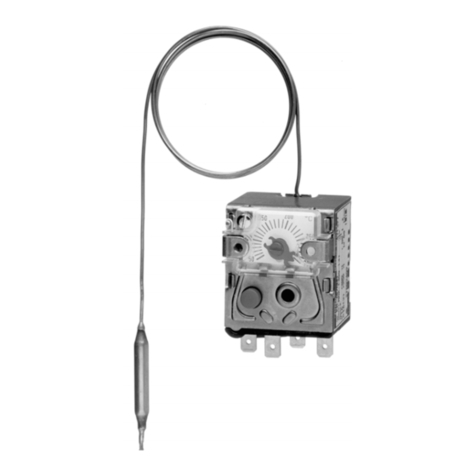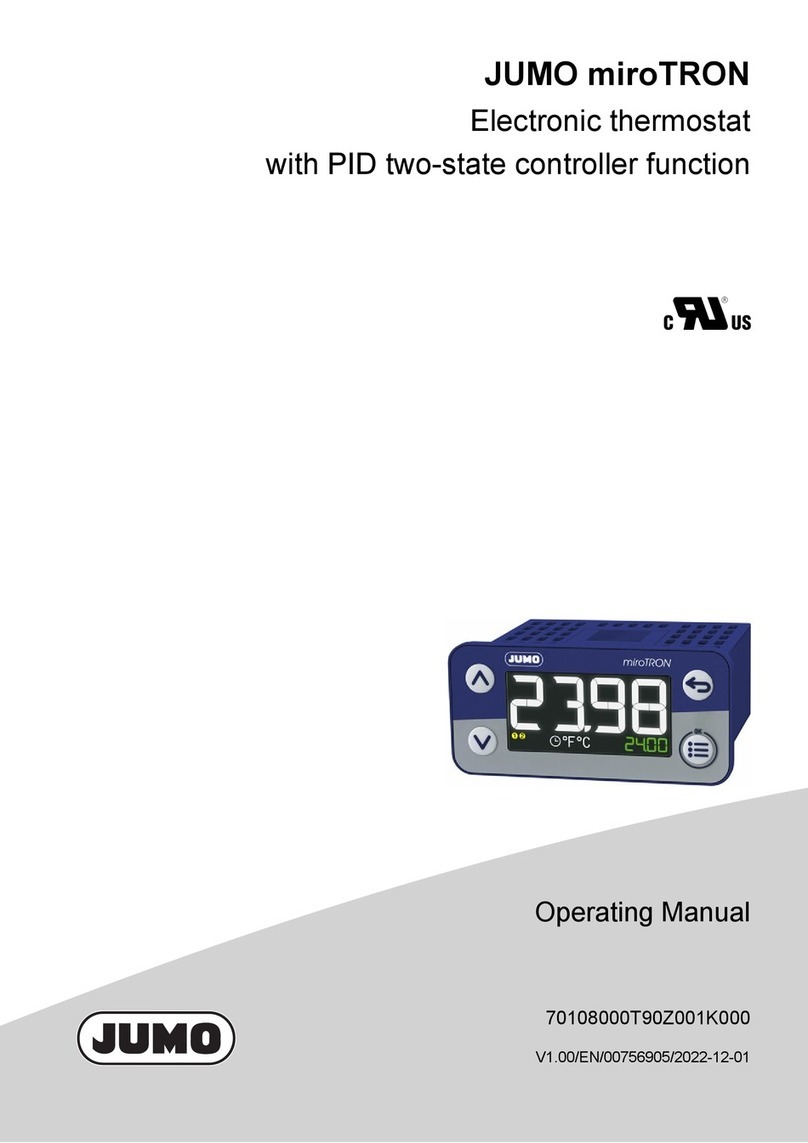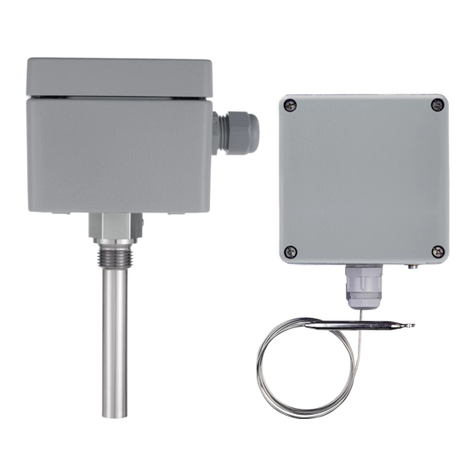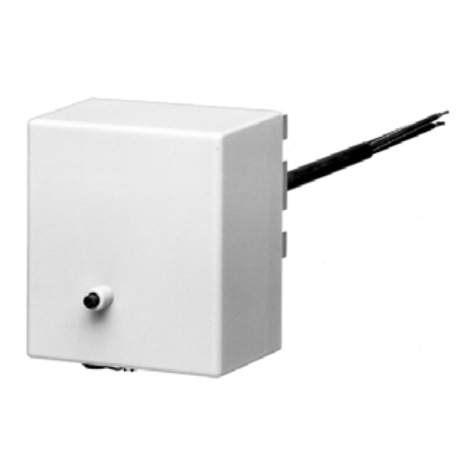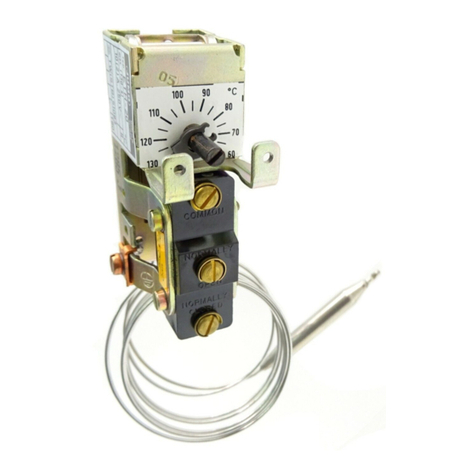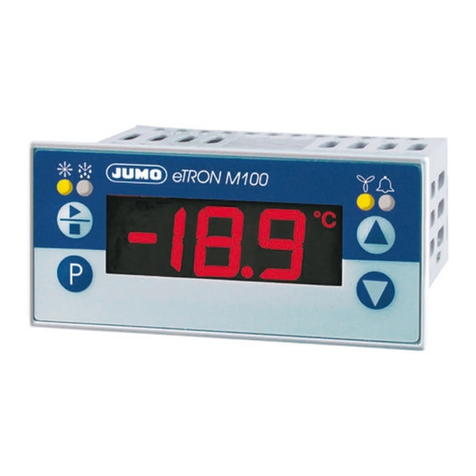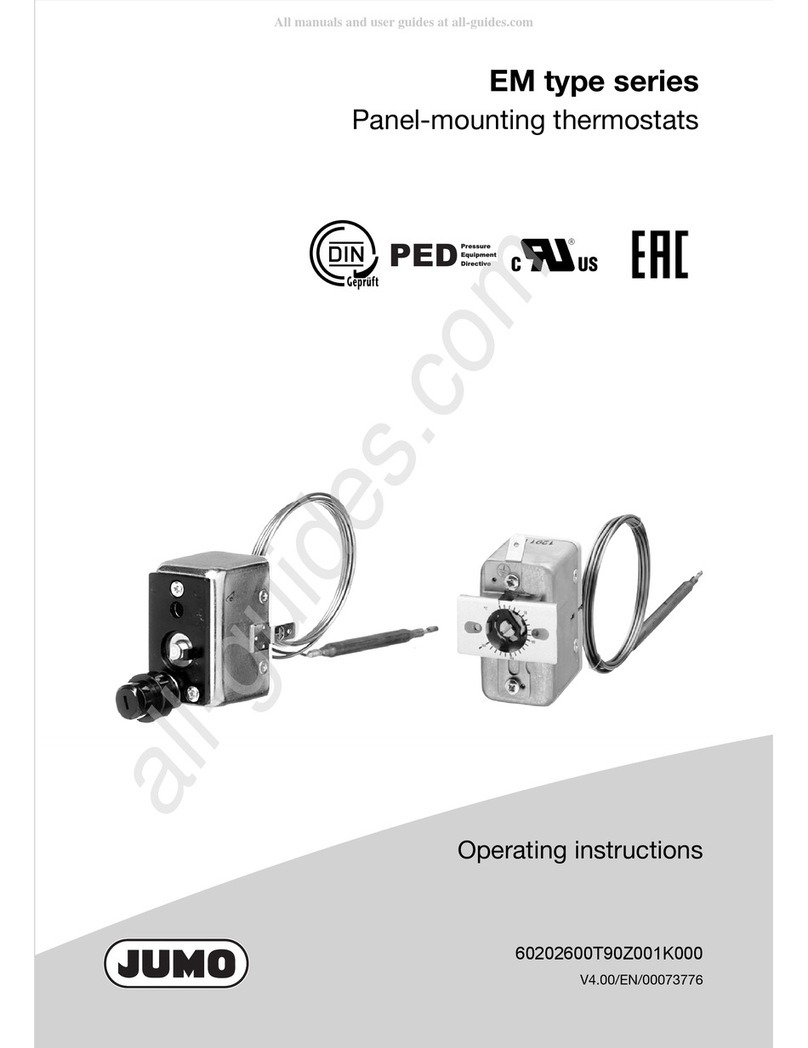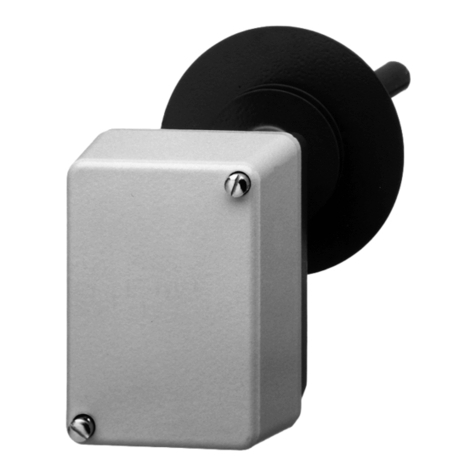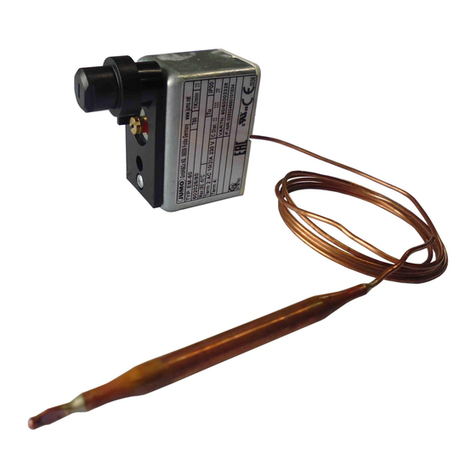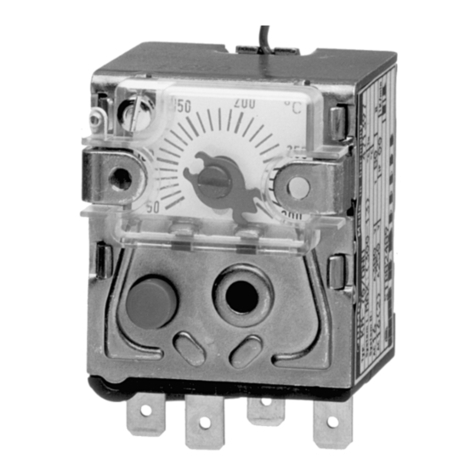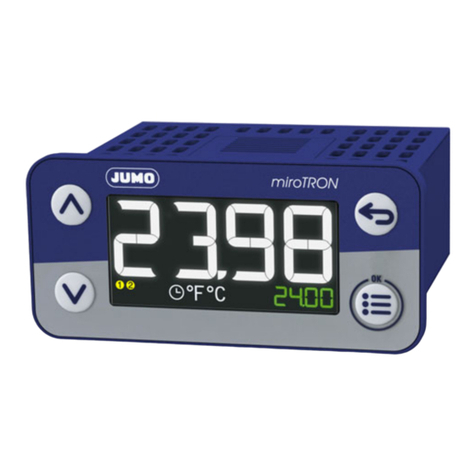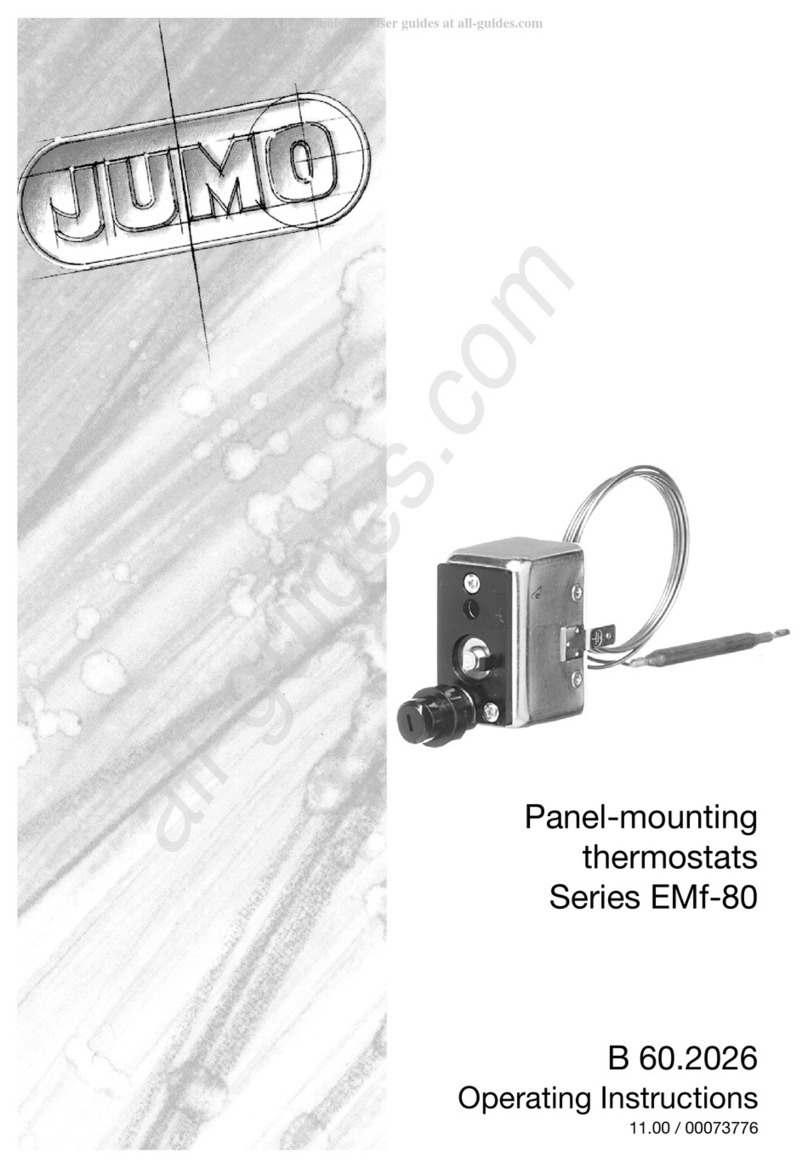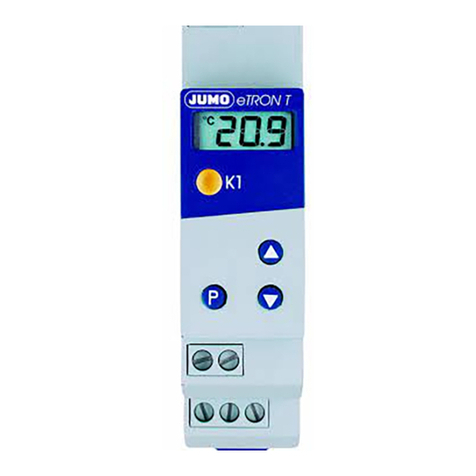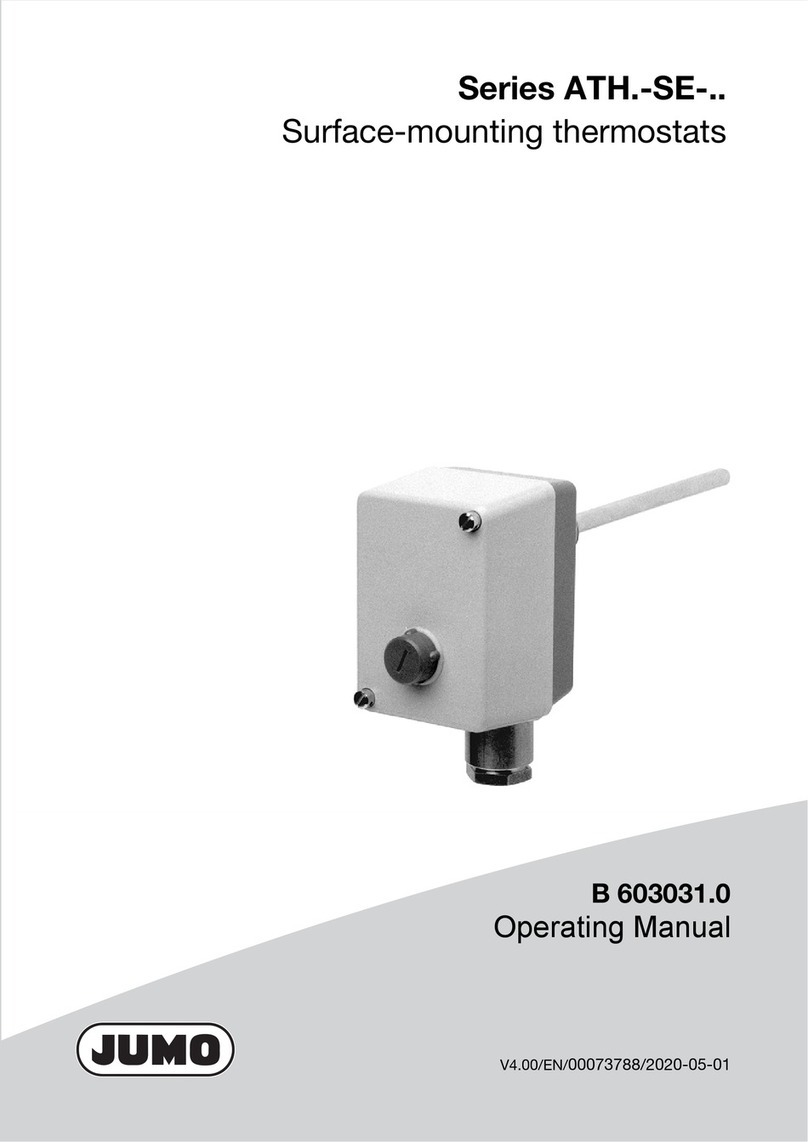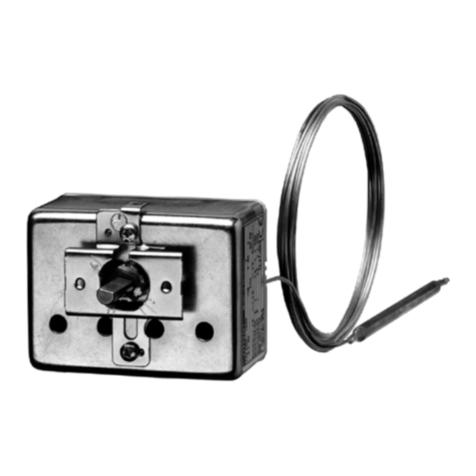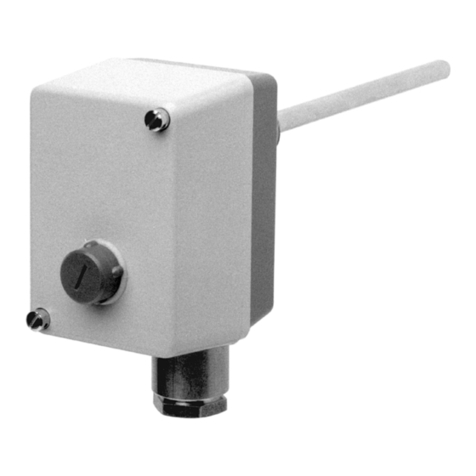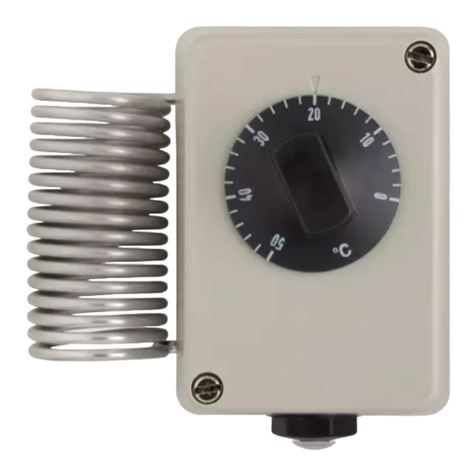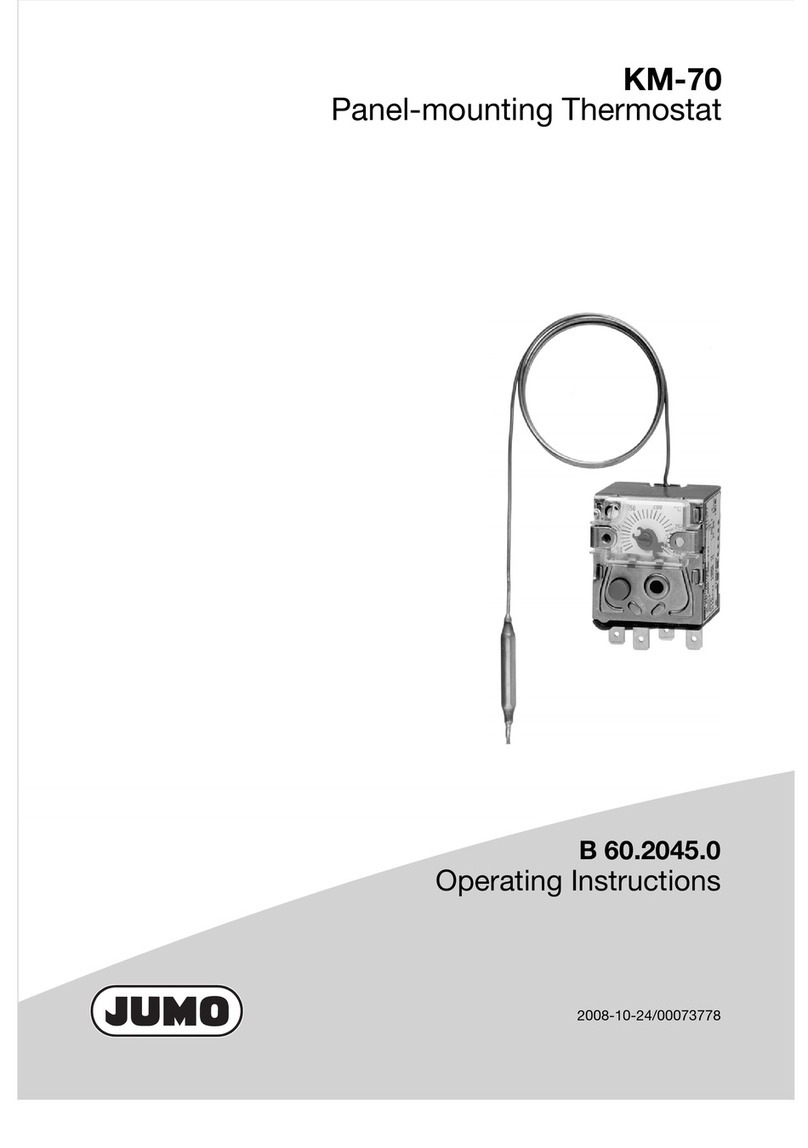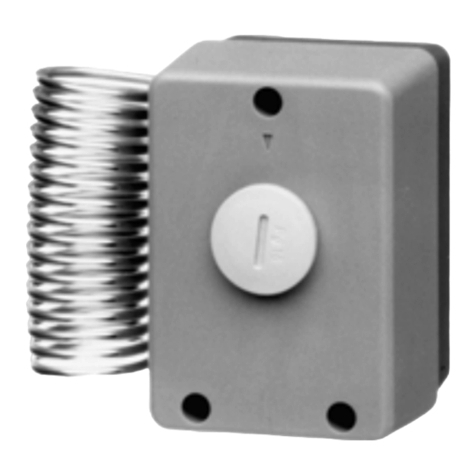
5.2 zulässige Anströmgeschwindigkeiten Permissible inflow velocities Vitesses d'écoulement recevable
Temperatur: +200°C Temperature: +200°C Température: +200°C
Wärmeträger: Luft ( 1 ), Wasser, Öl ( 2 ) Heat carrier: air ( 1 ), water, oil ( 2 ) Caloporteur: Air ( 1 ), eau, huile ( 2 )
Rohr-Ø „D“: 8 mm
Tube
-Ø „D“: 8 mm Ø-de la gaine „D“: 8 mm
10 mm 10 mm 10 mm
15 mm . . . . . . . . . . . . . . . . 15 mm . . . . . . . . . . . . . . . . 15 mm . . . . . . . . . . . . . . . .
Zulässige Anströmgeschwindigkeit (m/sec) bei maximal zulässiger Druckbelastung
und unterschiedlicher Tauchrohrlänge ( S ). Permissible incident flow velocity (m/sec) at maximum permitted pressure loading and
different immersion tube lengths ( S ). Vitesse d’écoulement admissible (m/sec) pour charge de pression maximale et lon-
gueurs du plongeur différentes „S“
( 1 ) Luft ( 2 ) Wasser, Öl ( S ) Tauchrohrlänge ( 1 ) air ( 2 ) water, oil ( S ) immersion tube length ( 1 ) Air ( 2 ) eau, huile ( S ) Longueur du plongeur
Tauchrohrlänge 200 mm: Werkstoff: Stahl Immersion tube length 200 mm: Material: steel Longueur du plongeur 200 mm: Matériau : acier
Temperatur: +200°C Temperature: +200°C Température: +200°C
Wärmeträger: Luft ( 1 ), Wasser, Öl ( 2 ) Heat carrier: air ( 1 ), water, oil ( 2 ) Caloporteur: Air ( 1 ), eau, huile ( 2 )
Rohr-Ø „D“: 8 mm
Tube
-Ø „D“: 8 mm Ø-de la gaine „D“: 8 mm
10 mm 10 mm 10 mm
15 mm . . . . . . . . . . . . . . . . 15 mm . . . . . . . . . . . . . . . . 15 mm . . . . . . . . . . . . . . . .
Zulässige Anströmgeschwindigkeit (m/sec) bei maximal zulässiger Druckbelastung
und unterschiedlicher Tauchrohrtemperatur ( t ). Permissible incident flow velocity (m/sec) at maximum permitted pressure loading and
different immersion tube temperatures ( t ). Vitesse d’écoulement admissible (m/sec) pour charge de pression maximale et lon-
gueurs du plongeur différentes „S“
( 1 ) Luft ( 2 ) Wasser, Öl ( t ) Temperatur ( 1 ) air ( 2 ) water, oil ( t ) temperature ( 1 ) Air ( 2 ) eau, huile ( t ) Température
5.3 Anschlussarten 50, 52 und 54
(Fühler direkt vom Medium berührt) Probe mountings 50, 52 and 54
(probe in direct contact with medium) Types de raccordement 50, 52 et 54
(sonde directement en contact avec le milieu)
Nippelwerkstoff:
Kupfer (CuZn) Stahl (St) Edelstahl (CrNi)
Nipple material:
Copper
(CuZn)
Steel
(St)
Stainless steel
(CrNi)
Matériau du manchon :
Cuivre (CuZn) Acier (St) Acier inoxydable (CrNi)
Max. Temperatur:
200°C 300°C 400°C
Max. temperature:
200°C 300°C 400°C
Température max. :
300°C 400°C
Fühlerwerkstoff Ø mm
Gerätefunktion
Probe material Ø mm
Device function
Matériau de la sonde Ø mm
Fonction de l’appareil
TW STB, STW (STB) TW STB, STW (STB) TW STB, STW (STB)
Cu-DHP 4 06bar
2bar
Cu-DHP 4 06bar
2bar
Cu-DHP 4 06bar
2bar
505bar 505bar 505bar
604bar 604bar 604bar
703bar 703bar 703bar
803bar 803bar 803bar
903bar 903bar 903bar
10 03bar 10 03bar 10 03bar
1.4571; St 35 4 - 10 010 bar 1.4571; St 35 4 - 10 010 bar 1.4571; St 35 4 - 10 010 bar
Die Prozessanschlüssse
10, 15, 21, 31, 60 und 65
dürfen nur in drucklosen Medien eingesetzt werden. Process connections
10, 15, 21, 31, 60 and 65
must only be used in unpressurized media.
Les raccords de process
10, 15, 21, 31, 60 et 65
peuvent uniquement être utilisés en milieu non soumis à la pression.
5.4 Fühlermontage Mounting the probe Montage de la sonde
Der Temperaturfühler ( 2 ) muss vollständig in das Medium eintauchen, da sonst
größere Schaltpunktabweichungen auftreten.
The temperature probe ( 2 ) must be fully immersed in the medium, other-
wise there will be appreciable variations in the switching point. La sonde de température (2) doit être entièrement immergée dans le milieu, afin
d’éviter des écarts du point de coupure trop importants.
Bei Thermostaten mit Fernleitung, Anschlussart „20“
und „22“ wird der Temperaturfühler arretiert, indem
über die Kapillarleitung ein Klemmbügel geschoben
und dieser in der erweiterten Hülsenöffnung durch
eine Schraube verklemmt wird.
Bei den Anschlussarten „50, 52, 54, 40, 41, 60 und
65“ ist der Fühler ab Werk durch den auf der Kapillar-
leitung befestigten Anschluss arretiert.
( 1 ) Klemmstück
(
2
) Temperaturfühler
( 3 ) Fernleitung
( 4 ) Schutzrohr
( 5 ) Andrückfeder
In the "20" and "22" probe mountings of thermostats
with capillary, the temperature probe is held in
position by sliding a clamping clip over the capillary
and clamping it with a screw in the enlarged open end
of the pocket.
With "50, 52, 54, 40, 41, 60 and 65" probe mountings,
the probe is held in position by the fitting attached to
the capillary at the factory.
(1)Clamp
(
2
) Temperature probe
(3)Capillary
( 4 ) Protection tube
(5)Springclip
En ce qui concerne les thermostats avec capillaire,
types de raccordement „20“ et „22“ la sonde de tem-
pérature est bloquée, pendant qu’un étrier de fixation
est placé via le capillaire dans l’ouverture du doigt de
gant et bloqué par une vis.
Pour les types de raccordement „50, 52, 54, 40, 41,
60 et 65“ la sonde est bloquée en usine par le raccor-
dement fixé sur le capillaire.
( 1 ) Etrier de serrage
(
2
) Sonde de température
(3)Capillaire
( 4 ) Gaine de protection
( 5 ) Ressort de pression
6. Installation (Vorschriften und Hinweise) Installation (Regulations and notes) Installation (Prescriptions et remarques)
V
●
Der elektrische Anschluss darf nur von Fachpersonal durchgeführt werden.
●
Bei der Wahl des Leitungsmaterials, bei der Installation und beim elektrischen Anschluss des Gerätes
sind die Vorschriften der VDE 0100 "Bestimmungen über das Errichten von Starkstromanlagen mit
Nennspannungen unter 1000 V" bzw. die jeweiligen Landesvorschriften zu beachten.
●
Das Gerät völlig vom Netz trennen, wenn bei Arbeiten spannungsführende Teile berührt werden können.
●
Gerät an der Klemme PE mit dem Schutzleiter erden. Diese Leitung sollte mindestens den gleichen
Querschnitt wie die Versorgungsleitungen aufweisen. Erdungsleitungen sternförmig zu einem gemein-
samen Erdungspunkt führen, der mit dem Schutzleiter der Spannungsversorgung verbunden ist. Er-
dungsleitungen nicht durchschleifen, d. h. nicht von einem Gerät zum anderen führen.
●
Neben einer fehlerhaften Installation können auch falsch eingestellte Werte am Thermostat den
nachfolgenden Prozess in seiner ordnungsgemäßen Funktion beeinträchtigen oder zu sonstigen Schä-
den führen. Die Einstellung sollte nur dem Fachpersonal möglich sein. Bitte in diesem Zusammenhang
die entsprechenden Sicherheitsvorschriften beachten.
●
The electrical connection must only be carried out by qualified personnel.
●
The choice of cable, the installation and the electrical connection must conform to the requirements of
VDE 0100 “Regulations on the Installation of Power Circuits with Nominal Voltages below 1000 V” and
the appropriate local regulations.
●
If contact with live parts is possible when working on the device, it must be completely disconnected
from the electrical supply.
●
Ground the instrument to the protective earth at the PE terminal. The cross-section of this cable must
be at least the same as that of the supply cables. Wire the grounding conductors in a star configura-
tion to a common earth point that is connected to the PE conductor of the electrical supply. Do not
loop the grounding cables, that is, do not run them from one instrument to another.
●
Apart from faulty installation, incorrect settings on the thermostat may also adversely affect the proper
functioning of the subsequent process or cause other damage. It should only be possible for qualified
personnel to make these settings. Please observe the relevant safety regulations for such matters.
●
Le raccordement électrique doit être effectué exclusivement par du personnel qualifié.
●
Veuillez respecter la réglementation en vigueur aussi bien pour le choix du matériel des lignes, pour
l’installation, que pour le raccordement électrique de l’appareil.
●
Débrancher totalement l’appareil du réseau lorsque des pièces sous tension peuvent être touchées
lors d’une intervention.
●
Mettre l’appareil à la terre à la borne PE. Cette ligne doit avoir la même section que les lignes d’ali-
mentation. Amener les lignes de mise à la terre en étoile à un point de terre commun, relié à l’alimen-
tation par le conducteur de protection. Ne pas boucler les lignes de mise à la terre, c-à-d ne pas les
amener d’un appareil à l’autre.
●
Outre une installation défectueuse, des valeurs mal réglées au niveau du thermostat peuvent égale-
ment porter préjudice au process suivant ou provoquer d’autres dégâts. Le réglage ne devrait être
effectué que par du personnel qualifié. Veuillez respecter à cet effet les instructions de sécurité qui
s’y réfèrent.
6.1 Elektrischer Anschluss
Das Gerät entspricht der Schutzklasse I.
Electrical connection
The device complies with protection class I.
Racordement électrique
L'appareil est conforme à la classe de protection I.
1.
Berührungsschutz abziehen.
2.
Anschlussleitung (Leitungsdurchmesser 5 bis 10 mm) durch die Verschraubung
(A)
führen. Schraubanschluss bis 2,5 mm
2
Leitungsquerschnitt.
3.
Anschluss gemäß entsprechendem Anschlussbild an Klemmen ( 1, 2 und 4 )
durchführen.
4.
Schutzleiter an Klemme "PE" anschließen.
5.
Berührungsschutz wieder aufstecken.
6.
Wiedereinschaltknopf
(B)
beim STB muß frei beweglich bleiben.
1.
Remove safety protection.
2.
Pass the connection cable (cable diameter 5 to 10 mm) through the compression
gland
(A)
. Screw connection up to 2.5 mm
2
conductor cross-section.
3.
Make the connection to the terminals ( 1, 2 and 4 ), as shown in the relevant
connection diagram.
4.
Connect the protective earth conductor to terminal "PE" .
5.
Replace the safety protection.
6.
The reset button
(B)
on the STB must be free to move.
1.
Retirer la protection contre les contacts accidentels.
2.
Passer le câble de raccordement (diamètre du câble : 5 à 10 mm) dans le raccord à
vis ( A ). Raccord fileté, section du fil : jusqu’à 2,5 mm
2
3.
Effectuer le raccordement aux bornes ( 1, 2 et 4 ) suivant le schéma de
raccordement.
4.
Ramener la terre à la borne "PE".
5.
Replacer la protection contre les contacts accidentels.
6.
Le bouton de réarmement ( B ) doit rester mobile avec STB.
Anschlussverbindung geeignet für fest verlegte Leitungen. Leitungseinführung ohne feste
Zugentlastung. Anbringungsart "X" (ohne besondere Zurichtung). The connection is suitable for fixed wiring. Cable entry is without fixed strain relief. Attach-
ment type "X" (no special tools). Raccordement adapté à des câbles avec pose fixe. Introduction du câble sans renforce-
ment de la jonction fixe. Type de montage "X" (sans préparation spéciale).
V
Cu-Kapillarrohr mit Schutzleiterfunktion
Bei CrNi-Kapillarrohren muss der Anwender selbst für den erforderlichen Schutz gegen
elektrischen Schlag sorgen.
Cu capillary tube with PE function
With CrNi capillary tubes it is the user's responsibility to provide the requisite protective
measures against electric shock.
Gaine du capillaire Cu avec fonction terre
Pour des capillaires NiCr „d’une longueur supérieure à 1000 mm“ l’utilisateur doit veiller lui-
même à la protection nécessaire contre les décharges électriques.
6.2
Anschlussbilder / Connection diagrams / Schémas de raccordement
Einfach-
Thermostat
Single
thermostats
Thermostats
simples
TW,
STW (STB)
mit
Umschalt-
kontakt
STB
mit Öffnungskontakt und
Wiedereinschaltsperre
Doppel-
Thermostat
Twin
thermostat
Thermostats
simples
System I und II:
mit Umschaltkontakt;
Schaltfunktion: TW, STW
Systems I and II:
with changeover contact;
switching function: TW, STW
Systèmes I et II :
avec contact inverseur Fonction de coupure : TW, STW
System I:
mit Umschaltkontakt Schaltfunktion: TW, STW
System II:
mit Öffnungskontakt und Wiedereinschaltsperrre;
Schaltfunktion: STB
System I:
with changeover contact switching function: TW, STW
System II:
with break contact and lock-out;
switching function: STB
Système I :
avec contact inverseur; Fonction de coupure : TW, STW
SystèmeII:
avec contact à ouverture et bouton de réarmement Fonction de coupure : STB
System I und II:
mit Öffnungskontakt und Wiede-
reinschaltsperre; Schaltfunktion: STB
Systems I and II:
with break contact and lock-out;
switching function: STB
Systèmes I et II :
avec contact à
ouverture et bouton de réarmement; Fonction de coupure : STB
with changeover contact
contact inverseur
with break contact and lock-out
avec contact à ouverture et bouton de réarmement
7.
Sollwert-/Grenzwerteinstellung
TW, STW (STB) und STB
Setpoint and limit setting
TW, STW (STB) and STB
Réglage de la consigne/du seuil
TW, STW (STB) et STB
1.
Gehäuse öffnen
2.
Grenzwert mit Schraubendreher
am Sollwertsteller ( 5 ) einstellen.
3
. Gehäuse schließen
( 1 ) oberer Anschlag
( 2 ) Sollwertzeiger
( 3 ) unterer Anschlag
( 4 ) Skalenteilung
( 5 ) Sollwertsteller
1.
Open the housing
2.
Use a screwdriver to set the limit
on the setpoint adjuster ( 5 ) .
3
. Close the housing
(1)upperstop
( 2 ) setpoint pointer
(3)lowerstop
( 4 ) scale graduation
( 5 ) setpoint adjuster
1.
Ouvrir le boîtier
2.
Régler la valeur limite à l’aide du tournevis
sur le bouton de consigne ( 5 ).
3
. Fermer le boîtier.
( 1 ) Butée supérieure
( 2 ) Repère de consigne
( 3 ) Butée inférieure
( 4 ) Graduation d’échelle
( 5 ) Potentiomètre
7.1
Entriegeln des STB Resetting the STB Déverrouillage de STB
Nach Unterschreiten des eingestellten
Grenzwertes (Gefahrentemperatur) um ca.
10% des Skalenumfanges kann der
Mikroschalter entriegelt werden.
1.
Gehäuse öffnen
2.
Wiedereinschaltknopf ( B ) drücken,
bis der Mikroschalter entriegelt ist.
3.
Gehäuse schließen
Once the temperature has fallen below the
set limit (safe temperature limit) by about
10% of the scale range, the microswitch
can be reset.
1.
Open the housing
2.
Press the reset button
(B)
until the microswitch is reset.
3.
Close the housing
Lorsque l’on descend sous la valeur limite
réglée d’environ 10 % (température à
risque) le microrupteur peut être déver-
rouillé.
1.
Ouvrir le boîtier
2.
Appuyer sur le bouton de réarmement ( B ),
jusqu’à ce que le microrupteur soit déverrouillé.
3.
Fermer le boîtier
7.3
Selbstüberwachung Self-monitoring Autosurveillance
Verhalten beim Bruch des Messsystems
Beim STB und STW (STB) wird bei Messsystembruch (Undichtheit) der Stromkreis bleibend geöffnet.
Beim STB wird der Mikroschalter zusätzlich verriegelt.
Response to a fracture of the measuring system
With the STB and STW (STB), a fracture of the measuring system (leaking) causes the circuit to stay
open permanently. With the STB, the microswitch is also locked.
Comportement en cas de rupture du système de mesure
Pour les exécutions STB et STW (STB) le circuit reste constamment ouvert (défaut d’étanchéité). Pour
l’exécution STB, le microrupteur se verrouille.
Verhalten bei Untertemperatur
Bei Abkühlung des Fühlers von STW (STB) und STB
in den negativen Temperaturbereich
öffnet sich der
Stromkreis, schließt sich jedoch bei Temperaturanstieg wieder. Nach Überschreiten der minimalen Fühler-
temperatur muss der STB manuell entriegelt werden.
Der STW (STB) entriegelt sich selbsttätig.
Response to low temperature
The electrical circuit opens when cooling the probe of STW (STB) and STB
down to the negative tem-
perature range
, but it then closes again if the temperature rises. The STB must be unlocked manually if
the minimum probe temperature is exceeded.
The STW (STB) unlocks itself automatically.
Comportement en cas de température inférieure
Si la
température
sur la sonde du STW (STB) ou du STB devient
négative
, le circuit électrique s’ouvre, toute-
fois il se referme lorsque la température remonte. Si la température est inférieure à la température de sonde
minimale, il faut déverrouiller manuellement le STB.
Le STW (STB) se déverrouille automatiquement.
V
Verwendung des STW (STB) als STB
Die geforderte Einschaltsperre muß durch die nachfolgende Schaltung gewährleistet werden. Diese
Schaltung muß der VDE 0116 entsprechen.
Using the STW (STB) as an STB
The required lock-out facility must be ensured by the subsequent circuit. This circuit must comply with
VDE 0116.
Utilisation de STW (STB) en tant que STB
La protection contre les réarmements imposée par la norme DIN 3440 doit être garantie par un mon-
tage conforme à la norme VDE 0116.
8.
Technische Daten Technical data Caractéristiques techniques
Wirkungsweise:
gemäß DIN EN 60730-1, DIN EN 60730-2-9 und DIN EN 14597
Mode of operation:
to EN 60730-1, EN 60730-2-9 and EN 14597
Fonctionnement :
to EN 60730-1, EN 60730-2-9 et EN 14597
TW:
2BL
STW (STB):
2BKLNP
STB:
2BFHKLNPV
TW:
2BL
STW (STB):
2BKLNP
STB:
2BFHKLNPV
TW:
2BL
STW (STB):
2BKLNP
STB:
2BFHKLNPV
zulässige Umgebungstem-
peratur im Gebrauch:
An Fernleitung und Schaltkopf: siehe Typenschildangabe
am Fühler: max. Sollwert +25 K bzw. +15%
Permissible ambient tem-
perature during use:
At high-voltage line and switch head: see type plate specification
At probe: max. setpoint value +25 K or +15%
Température ambiante admis-
sible en cours d’utilisation :
Sur le capillaire et la tête : voir indications sur la plaque signalétique
Sur la sonde : consigne max. +25 K ou +15%
zulässige Lagertemperatur:
max. 50°C, min. -50°C
Permissible storage temperature:
max. 50°C, min. -50°C
Température de stockage admissible :
max. 50°C, min. -50°C
Schaltpunktgenauigkeit:
in % vom Skalenumfang, vom Regel-/Grenzwertbereich
Switching point accuracy:
Switching point accuracy in % of the control / limit value range
Précision du point de contact :
en % de la plage de réglage / valeurs limites
TW:
im oberen Drittel der Skala ± 1,5%, am Skalenanfang ± 6%
TW:
in the upper third of the scale ± 1.5%, at scale beginning ± 6%
TW:
dans le tiers supérieur de l’échelle ± 1,5%, en début d’échelle ± 6%
STB, STW (STB):
im oberen Drittel der Skala +0/-5%, am Skalenanfang +0/-10%
STB, STW (STB):
in the upper third of the scale +0/-5%, at scale beginning +0/-10%
STB, STW (STB):
dans le tiers supérieur de l’échelle +0/-5%, en début d’échelle +0/-10%
mittlerer Umgebungstem-
peratureinfluss
in % vom Skalenumfang, bezogen auf den Grenzwert. Bei einer
Abweichung der Umgebungstemperatur am Schaltkopfgehäuse
und / oder der Fernleitung von der Kalibrier-Umgebungstemperatur
+22°C, entsteht eine Schaltpunktverschiebung.
Höhere Umgebungstemperatur = niedrigerer Schaltpunkt
Niedrigere Umgebungstemperatur = höherer Schaltpunkt
Mean ambient
temperature effect
as % of scale range, relative to limit value. If the ambient tempera-
ture at the thermostat head housing and / or the capillary deviates
from the calibration ambient temperature value of +22
°
C in, this
shifts the switching point.
Higher ambient temperature = lower switching point
Lower ambient temperature = higher switching point
Influence de la température
ambiante moyenne
En % de l’étendue de mesure, par rapport à la valeur limite.
Si la température ambiante sur le boîtier de la tête et/ou le capillaire
est différente de la température ambiante de calibrage (+22 °C), le
point de contact est déplacé.
Température ambiante supérieure = point de contact plus bas
Température ambiante inférieure = point de contact plus haut
Aufbau-Thermostate mit Skalenendwert
Surface-mounting thermostats with end of scale Thermostats pour montage en saillie avec valeur fin d’échelle
< +200°C
≥
+200°C
≤
+350°C < +200°C
≥
+200°C
≤
+350°C < +200°C
≥
+200°C
≤
+350°C
TW STB/STW (STB) TW STB/STW (STB) TW STB/STW (STB) TW STB/STW (STB) TW STB/STW (STB) TW STB/STW (STB)
Einfluss auf den Schaltkopf
Effect on the thermostat head Influence sur le boîtier
0,08%/K 0,17%/K 0,06%/K 0,13%/K 0,08%/K 0,17%/K 0,06%/K 0,13%/K 0,08%/K 0,17%/K 0,06%/K 0,13%/K
Einfluss auf die Fernleitung pro Meter
Effect on capillary per meter Influence sur le capillaire par mètre
0,047 %/K 0,054 %/K 0,09 %/K 0,11 %/K 0,047 %/K 0,054 %/K 0,09 %/K 0,11 %/K 0,047 %/K 0,054 %/K 0,09 %/K 0,11 %/K
Aufbau-Thermostate mit Skalenendwert
Surface-mounting thermostats with end of scale Thermostats pour montage en saillie avec valeur fin d’échelle
≥
+350
°
C
≤
+500
°
C
≥
+350
°
C
≤
+500
°
C
≥
+350
°
C
≤
+500
°
C
TW STB/STW (STB) TW STB/STW (STB) TW STB/STW (STB)
Einfluss auf den Schaltkopf
Effect on the thermostat head Influence sur le boîtier
0,14%/K 0,12%/K 0,14%/K 0,12%/K 0,14%/K 0,12%/K
Einfluss auf die Fernleitung pro Meter
Effect on capillary per meter Influence sur le capillaire par mètre
0,04 %/K 0,03 %/K 0,04 %/K 0,03 %/K 0,04 %/K 0,03 %/K
maximal zulässige
Schaltleistung
(ergänzende Angaben zum
Typenschildaufdruck)
AC 230 V +10%, 10(2) A, cos j = 1(0,6)
DC 230 V +10%, 0,25 A bzw.
AC 230 V +10%, 6(1,2) A, cos j = 1(0,6)
bei Mikroschalter mit Goldauflage, Typenzusatz /au, AC/DC 24 V, 0,1 A
Maximum permissible
contact rating
(additional info to details on
nameplate)
AC 230 V +10%, 10(2) A, cos j = 1(0,6)
DC 230 V +10%, 0,25 A or
AC 230 V +10%, 6(1,2) A, cos j = 1(0,6)
f
or gold-plated microswitch, code /au, AC/DC 24 V, 0,1 A
Pouvoir de coupure
max. admissible
(informations complémentaires
concernant la plaque signalétique)
230 V AC +10%, 10(2) A, cos j = 1(0,6)
230 V DC +10%, 0,25 A
ou
230 V AC +10%, 6(1,2) A, cos j = 1(0,6)
pour microrupteur avec revêtement doré, option /au, 24 V AC/DC, 0,1 A
Kontaktsicherheit
Zur Gewährleistung einer möglichst großen Schaltsicherheit em-
pfehlen wir eine Mindestbelastung von:
AC/DC 24 V, 20 mA bei Silberkontakten (Standard)
AC/DC 10 V, 10 mA bei vergoldeten Kontakten (Typenzusatz /au)
Contact reliability
To ensure maximum switching reliability, we recommend
a minimum loading of:
24 V AC/DC, 20 mA for silver contacts (standard)
10 V AC/DC, 10 mA for gold-plated contacts (code /au)
Sûreté du contact
Nous vous recommandons, pour une sécurité de coupure maximale,
une charge minimale de:
24 V AC/DC, 20 mA avec contacts argentés (exécution standard)
10 V AC/DC, 10 mA avec contacts dorés (option /au)
Bemessungs-Stoßspannung
2500 V
Rated surge voltage
2500 V
Surtension transitoire de référence
2500 V
Überspannungskategorie II
Erforderliche Absicherung, siehe maximaler Schaltstrom
Overvoltage category II
For required fusing, see maximum switching current
Catégorie de surtension II
Protection par fusibles nécessaire, voir courant de commutation max.
Betriebsmedium
Wasser, Öl, Luft, Heissdampf
Operating medium
Water, oil, air, superheated steam
Milieu d’utilisation
Eau, huile, air, vapeur
Zeitkonstante t
0,632
in Wasser in Öl in Luft / Heissdampf
Time constant t
0,632
in water in oil in air / superheated steam
Constante de temps t
0,632
dans l’eau dans l’huile dans l’air/vapeur
≤
45 s
≤
60 s
≤
120 s
≤
45 s
≤
60 s
≤
120 s
≤
45 s
≤
60 s
≤
120 s
Schutzart
EN 60 529 - IP 65, Einsatz unter normalen Bedingungen
Enclosure protection
EN 60 529 - IP 65, use under normal conditions
Indice de protection
EN 60 529 - IP 65, use under normal conditions
